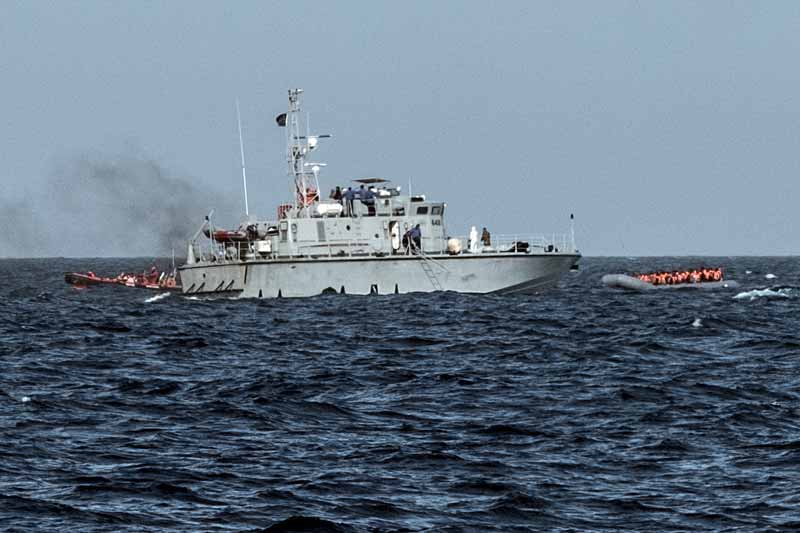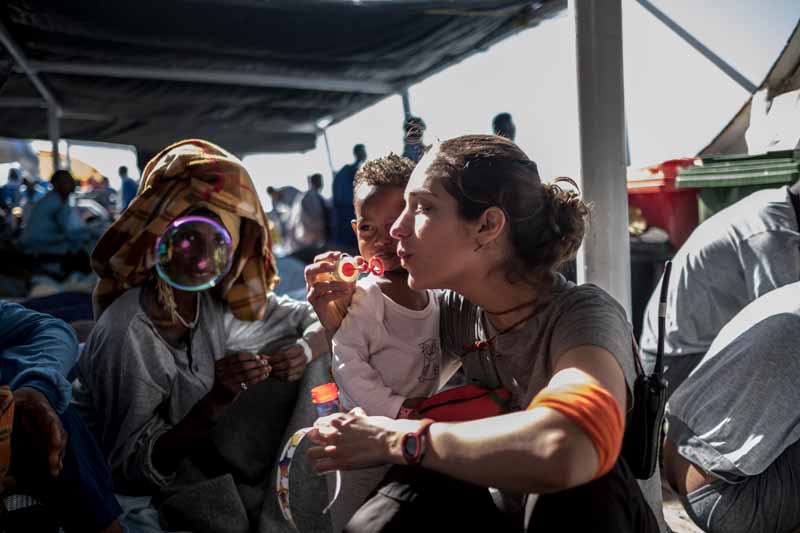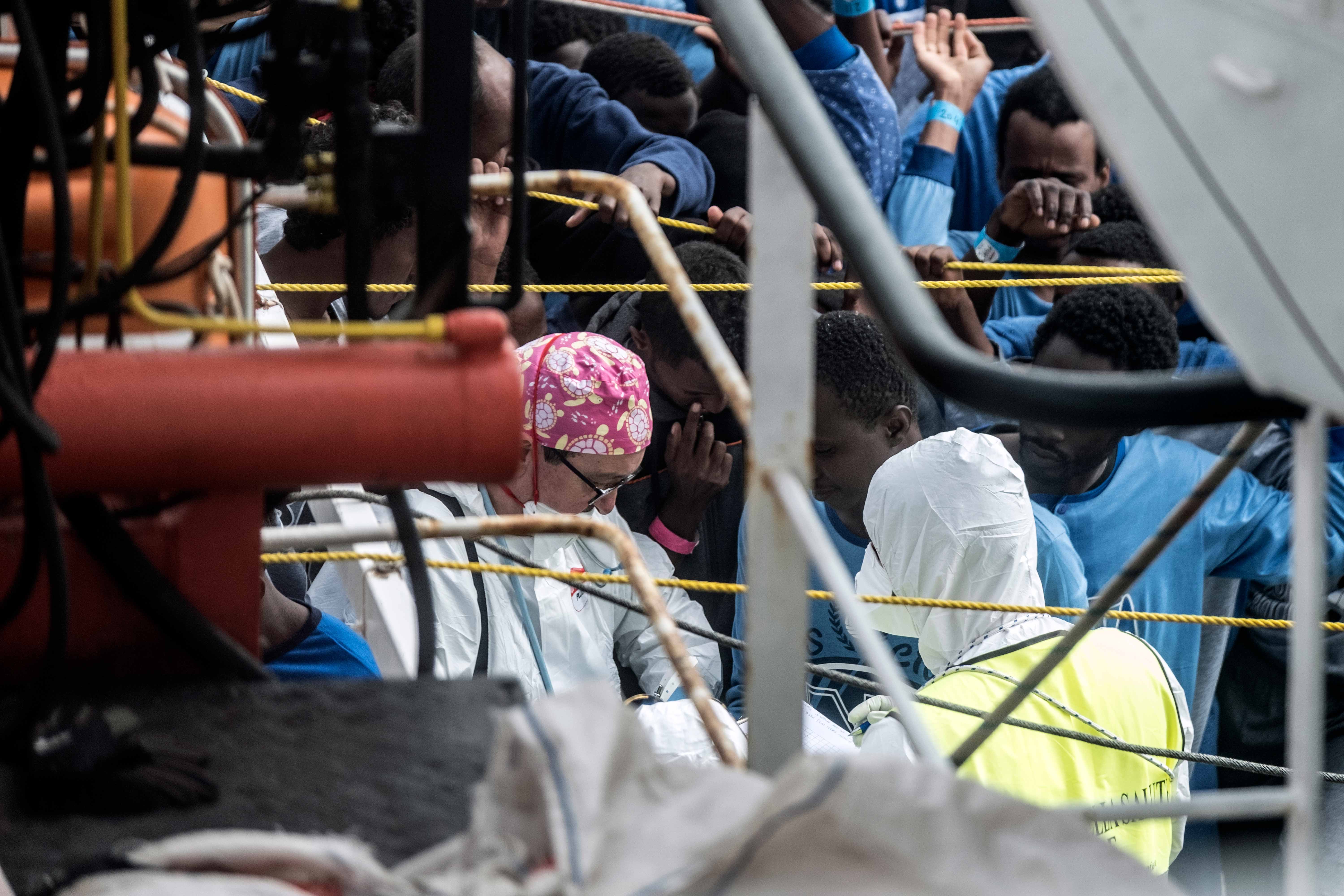Parties involved
Dinghies
Three inflatable boats crowded with migrants from various African nationalities flee from Libya to try to reach Italy
Italian Army
Italian military forces that cooperate with the government of Tripoli to curb immigration to Italy
MRCC Rome
Rescue Coordination Centre in Rome, responsible for maritime rescue and answering to Italy
Libya
The North African country is suffering a civil war since 2011, with three governments that fight for its control. One of them, based in Tripoli, is recognized by the EU as a representative to stop migrants with their coastguards
Open arms
Rescue ship of the NGO from Badalona (Spain) Proactiva Open Arms in the Central Mediterranean
Rescue lifeboats
To get as fast as possible to the castaways, the 'Open Arms' has two fast rescue lifeboats
* The reference time is the 'Open Arms' on-board log time, which coincides with Spanish time. The ship's security cameras show one hour ahead.
Març 14th
14.00
Open arms
The 'Open Arms' leaves the Port of Valletta (Malta) heading to the rescue area, estimating to get there the next day around six in the morning.

Three dinghies leave Libya in the middle of the night
Three inflatable boats leave from a beach of the Libyan city, Gasr Garabulli. "Some of my friends stayed behind because we tried to get them to bring another rubber boat but the smuggler didn’t want to. Business is business,” explains a Libyan young man who travelled in the second dinghy. Garabulli is a town 40 minutes east of Tripoli ruled by the Tajoura militia, out of the control of Fayez al Sarraj's government.
22.00
Dinghies
The first dinghy leaves.
23.00
Dinghies
The second dinghy leaves.
23.59
Dinghies
The third dinghy leaves
Març 15th
04.21
Italian Army
A drone from Operation Sophia of the European Union Naval Force Mediterranean sees one of the dinghies, 40 nautical miles to the northeast of Tripoli, in international waters. It is reported by the ship 'Capri' of the Italian Navy, which, in the framework of the Nauras Operation of cooperation between Italy and Libya, is based at the port of Tripoli. See article. The Italian military ship informs the Libyan coastguards on the position of the dinghy.
04.56
MRCC Rome
The Rescue Coordination Centre in Rome informs the 'Open Arms' about the location of a dinghy. The case number assigned to it is 164.
05.37
Italian Army
The Italian military ship 'Capri' reports to the Maritime Rescue Coordination Center in Rome that patrol boat 'Gaminez', of the Tripoli Coast Guard, will leave the port of Homs (Al Khums) to take charge of the rescue. If the 'Open Arms' launched its rescue lifeboats that instant, it would have taken them half an hour to reach the site. However, the Libyan patrol boat would need at least one hour and a half to reach the point if setting sail immediately.
06.22
Rescue lifeboats
The 'Open Arms' releases its two rescue lifeboats, which sail towards the set position at top speed. This is the usual procedure of the NGO: the rescue lifeboats sail to the site as fast as they can, loaded with life jackets, while the 'Open Arms' follows them behind at a slower pace.
Libya
The Libyan coastguards inform MRCC Rome that they will coordinate the rescue. They don’t give an estimated time of arrival of the 'Gaminez' patrol boat at the spot where the dinghy is.
06.50
MRCC Rome
MRCC Rome informs the 'Open Arms' that the Libyan coastguards are taking control of the rescue. They specify that two Libyan patrol boats are en route to the site and from that moment on, they are no longer in charge of the rescue.
07.20
Italian Army
The Italian military helicopter 'Nave Alpino' detects three dinghies and it hovers over the area.
07.57
MRCC Rome
MRCC Rome informs the 'Open Arms' about the position of another dinghy: the third one to leave Libya.
08.22
MRCC Rome
MRCC Rome informs the 'Open Arms' that the Libyan coastguards will also be in charge of the rescue of the second dinghy. The 'Open Arms' is sent to rescue the third rubber boat sailing to the west.
Rescue lifeboats
The two rescue lifeboats are heading to the site.
08.44
MRCC Rome
MRCC Rome warns the 'Open Arms' that the Libyan coastguards will be in charge of the rescue of the third dinghy as well.
Open arms
The 'Open Arms' responds that they will continue searching for castaways in the area.
First rescue: 101 people in serious danger
09.00
Rescue lifeboats
One of the rescue lifeboats finds the first dinghy (case 166) and informs MRCC Rome of its position. They try to warn the Libyan coastguards but they are neither seen nor respond to calls through the rescue radio channel. The rubber boat is partially deflated, which lets water in and some of the migrants are half sunk.
Open arms
The 'Open Arms' reports the situation to MRCC Rome, who authorizes them to proceed with the rescue. As explained by the castaways, the engine of their dinghy stopped working at five in the morning: that is why they are the ones closer to the Libyan coast, 26 miles away.
09.13
Rescue lifeboats
Volunteers start distributing life jackets from the rescue lifeboats to the castaways. There are 117 people on board of the dinghy, including 8 women, one of them being pregnant. They are from Mali (54), Guinea-Conakry (26), Côte d'Ivoire (15), Senegal (13), Nigeria (4), Liberia, Cameroon, Gambia, Sudan and Equatorial Guinea.
10.03
Open arms
When the 'Open Arms' arrives at the site they start transferring the castaways to the ship.
10.42
Open arms
During the rescue, the small plane 'Moonbird' of the NGO Sea-Watch informs the 'Open Arms' of the position of two dinghies northwards.
Rescue lifeboats
Once all the castaways are on board the rescue ship, the rescue lifeboats sail to the new position.
12.27
Rescue lifeboats
One of the rescue lifeboats finds an empty dinghy. MRCC Rome is informed, and they say that they have probably been rescued by the Libyan coastguards. According to the testimonies of the refugees, this is the third rubber boat that left Libya. The rescue lifeboats continue searching for the third dinghy to the north.
13.13
Libya
Tripoli coastguards inform the Italian authorities that patrol boat 'Gaminez' has reported it is getting out of range and must return to the port of Tripoli. This patrol boat passes the 'Open Arms' at great speed loaded down with migrants. It is replaced by the patrol boat 'Ras Al Jadar', identified with number 648. The next day the Coast Guard posts on its own Facebook page a statement in which they explain that on March 15th patrol boat 'Gaminez' rescued 96 people.
Patrol boat 'Ras Al Jadar' threatens to kill the volunteers during the second rescue
13.50
Libya
Patrol boat 648, a gift from the Italian Government to Libya with EU-trained personnel, passes in front of the prow of the 'Open Arms' at high speed making acoustic signals.
Open arms
The captain asks the rescue lifeboats to be cautious as the libyans have displayed a hostile attitude. The castaways from the first rescue, which are on deck of the 'Open Arms', duck down to avoid being seen by the coastguards. The captain orders everyone to leave the bridge.
13.59
Rescue lifeboats
The rescue lifeboats find dinghy 164. MRCC Rome is informed. Given the situation of the castaways, lifejackets are distributed and children and their mothers are put on board: a total of 44 people.
14.50
Libya
Libyan patrol boat 648 arrives at the position of the dinghy and threatens to kill the volunteers if they don’t hand them back the children and women who are on board the rescue lifeboats.
Open arms
The 'Open Arms' loses satellite communications and communication with the rescue lifeboats. The tension at the bridge raises due to the uncertainty of the volunteers’ situation after the threats of the Libyan commander. Suddenly, black smoke is seen in the area and triggers all alarms. It turns out to be smoke coming from the engine of the patrol boat itself. Afterwards, radio communication with the rescue lifeboats is recovered.
Libya
The patrol boat chases the rubber boat, which tries to escape. One of the coastguards recovers an abandoned boat from the sea and uses it to pursue the dinghy as well.
14.54
MRCC Rome
The Maritime Rescue Centre of Rome informs the Italian Navy of the situation and asks them if they are ready to send a ship to guarantee everyone's safety. The Operations Centre of the Commander in Chief Naval Fleet (CINCNAV) responds that they will not intervene because Libya is a sovereign state that already has an official ship involved.
15.20
Open arms
The 'Open Arms' presses the SSAS (Ship Security Alert System) anti-piracy button.
15.48
Open arms
The 'Open Arms' gets its satellite communications back.
16.15
Open arms
The 'Open Arms' arrives at the position of the rescue lifeboats and the captain contacts the commander of the Libyan patrol boat.
16.54
Open arms
Some of the migrants, scared, throw themselves into the water to avoid being captured by Libyan agents. Later, they will explain that they would rather die than being forced to return to Libya. The Open Arms cannot intervene. The captain asks the coastguards for permission to rescue people from the water.
17.17
Libya
The Libyan coastguards force one of the rescue lifeboats to approach patrol boat 648. The skipper of the rescue lifeboat informs the 'Open Arms' that one of the Libyan agents has climbed aboard without authorization and is attempting to take by force the rescued migrants, which are trying to resist him. The captain of the Open Arms insists they don't have permission to board the lifeboats.
17.20
Libya
Finally, the coastguards give up and authorize the 'Open Arms' to go ahead with the rescue. But they keep watching the NGO’s ship, within a short distance, for about two hours.
17.30
Open arms
101 more people climb aboard: they are mostly Eritreans, in addition to two South Sudanese, a Gambian and two Senegalese. On deck they join the 117 castaways from the first rescue. Volunteers offer them dry clothes, water and food, and the medical team attends the weakest.
Two days without a port where the castaways can disembark
18.35
Open arms
The 'Open Arms' informs MRCC Rome they carry a total of 218 migrants on board and requests a safe harbour to disembark them. Italy, in an unheard-of move, responds that they should talk to Spain, the flag state of the ship, because the rescue has been done outside their coordination. The ship begins to sail slowly, heading north, awaiting instructions.
Març 16th
Open arms
With the 218 refugees on board, it sails for 24 hours towards the north waiting to be informed of a safe harbour. MRCC Rome insists that it is Spain who has to solve the situation. In a given moment, MRCC Madrid indicates that the nearest port is Malta, even though this country has not welcomed refugees for years. With three meters high waves, the migrants spend all night on the deck of the 'Open Arms'. Volunteers look after them as well as they can: they make rice and couscous and baby bottles for the youngest. This will be their third night in high seas.
08.00
Open arms
The medical team is alarmed by the state of Selioum, a 3 months old baby girl of an Eritrean refugee, who suffers from malnourishment, dehydration and a widespread infection of scabies. During the night the little one has refused to take any milk and her health deteriorates. A medical evacuation is requested to the nearest port, La Valetta (Malta). The Maltese authorities send a maritime rescue lifedboat to the 'Open Arms' to take the baby and her mother to a Malta hospital. The baby girl and her mother eventually recovered.
Març 17th
In Europe at last, but chased by the Italian Prosecutor's Office
09.00
Open arms
The odyssey of the castaways is over when they step on European soil. Some celebrate by singing Alpha Blondy's reggae songs, others with prayers. Europe receives them with people in uniforms, masks and rubber gloves. The volunteers say goodbye with a hug. The road ahead will not be easy for the survivors of the Mediterranean.












